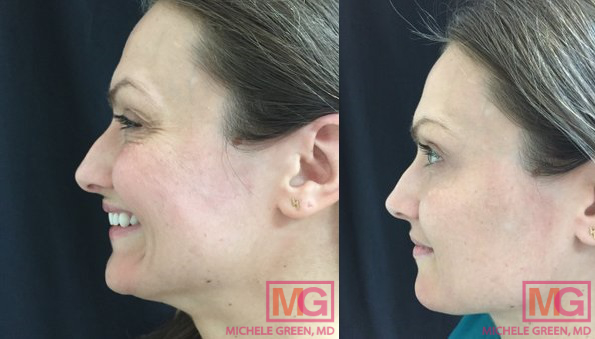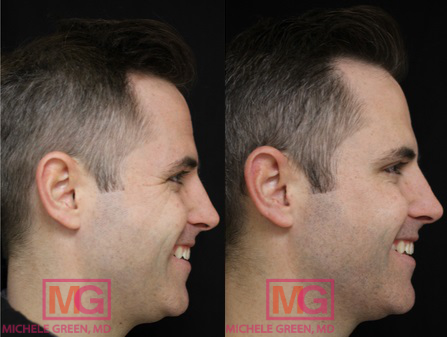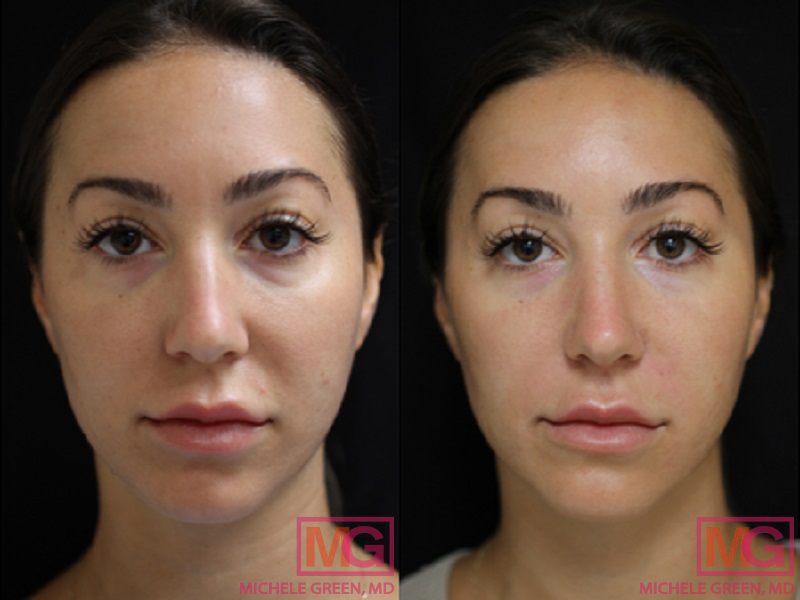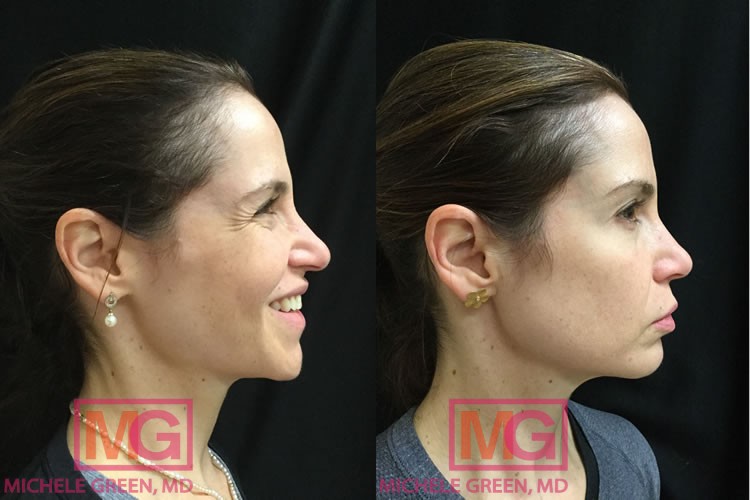Botox Under Eyes
The eyes are the most expressive part of the face and one of the areas where signs of the natural aging process can be most apparent. The eyes are the most expressive part of the face and one of the areas where signs of the natural aging process can be most evident. As we age, collagen and elastin levels decrease, leading to loose skin and wrinkles on the thinner, more delicate skin under the eyes. Additionally, due to facial expressions such as smiling, laughing, and squinting, dynamic wrinkles, often referred to as crow’s feet, can develop around the eyes. Crow’s feet and under-eye wrinkles can be distressing for some patients who seek the best methods to eliminate these signs of aging. Many patients believe that to reduce signs of aging around the eyes, they must undergo invasive cosmetic surgery with a plastic surgeon. However, there are non-surgical options for minimizing the appearance of wrinkles around the eyes, available at Dr. Michele Green’s New York City cosmetic dermatology office.
Botox is the gold standard for treating dynamic wrinkles, such as crow’s feet around the eyes. The neuromodulation “freezes” the treated muscles to reduce the overall appearance of fine lines and wrinkles that develop from repeated facial expressions. Many patients appreciate the benefits of Botox, which offers stunning cosmetic results without the need for plastic surgery or intensive aftercare. Wrinkles that form directly under the eyes can be addressed with other non-invasive procedures, such as laser resurfacing, which targets thinning, loose skin. Laser treatments, such as eMatrix and Fraxel, can boost collagen production in the area, tightening the skin and reinforcing its structural network to reduce under-eye wrinkles. When you consult with Dr. Green about the wrinkles around your eyes, she will create a treatment plan that is right for your eye rejuvenation.
Dr. Michele Green is an internationally renowned, board-certified dermatologist with over twenty-five years of experience providing some of the world’s most discerning individuals with the finest non-invasive treatment options. Dr. Green takes a holistic approach and embraces a less-is-more philosophy regarding facial rejuvenation, customizing each patient’s plan to incorporate a unique combination of in-office treatments and specially formulated skincare products that best address their specific concerns and aesthetic goals. She is consistently recognized as one of New York City’s top dermatologists by New York Magazine, Castle Connolly, Super Doctors, and the New York Times for her dedication to patients and expertise. Dr. Green utilizes cutting-edge technologies and innovative treatment techniques to help her patients look and feel their best.
What are Botox injections?
Botox is a brand name for botulinum toxin type A. This injectable treatment is used for both medical and cosmetic purposes and is considered the best option for reducing dynamic facial wrinkles. Approved by the FDA in 2002 as a safe and effective cosmetic treatment, Botox has gained immense popularity due to its ability to produce incredible, natural-looking results with no downtime. It is regarded as the gold standard for diminishing dynamic facial lines and wrinkles. These fine lines develop over time due to repetitive facial expressions, such as squinting, smiling, laughing, and frowning. They are commonly found at the corners of the eyes (crow’s feet), on the forehead, and between the eyebrows (glabella frown lines). In addition to treating forehead lines, Botox can be injected along the eyebrows to produce a brow lift. As a neuromodulator, Botox works by blocking nerve signals and limiting muscle contractions when injected into targeted facial muscles, effectively “freezing” them. Dynamic fine lines arise from age-related loss of collagen and elastin, which reduces skin elasticity and its ability to rebound. Botox can prevent and reverse these signs of aging, allowing patients to maintain a youthful appearance.
How does Botox work?
Botox is considered the gold standard for treating dynamic wrinkles, such as crow’s feet. Crow’s feet are the fine lines at the corners of your eyes that become more noticeable with facial expressions like smiling, laughing, and squinting. Botox is a neurotoxin that contains botulinum toxin type A or onabotulinumtoxinA. It blocks the nerve signals responsible for muscle movement in any targeted treatment area. When injected into the intended muscles, Botox prevents the nerve signals that cause wrinkles, smoothing them out. The effects of Botox can take up to two weeks to become noticeable, after which they typically last for three to four months. Most patients undergo regular maintenance Botox treatments to sustain their desired results. Due to Botox’s ability to reduce the appearance of fine lines and wrinkles, it can be used not only to lessen the signs of aging as they appear but also as a preventive measure to stop wrinkles from forming before they etch into the skin. Botox is a safe and effective option for dynamic wrinkles and fine lines when administered by an experienced, board-certified dermatologist, like Dr. Michele Green in New York City.

What causes under-eye wrinkles?
Undereye wrinkles are primarily caused by a combination of natural aging, sun exposure, and lifestyle choices. As we age, our skin naturally loses collagen and elastin, resulting in thinning and sagging in sensitive areas, such as the under-eye area. This process is exacerbated by ultraviolet (UV) radiation from the sun, which breaks down collagen and damages skin cells. Other contributing factors include genetics, smoking, inadequate sleep, and dehydration. As such, these wrinkles do not respond to Botox treatment and, in some cases, can be exacerbated if they are injected with Botox. Thankfully, Dr. Green offers a variety of non-invasive treatments to improve under-eye wrinkles.
Can you do Botox under the eyes?
Botox is specifically FDA-approved to treat wrinkles at the corners of the eyes, but it has not received approval for creases in the under-eye area or lower eyelid. Botox should not be applied under the eyes without FDA approval. Few studies have assessed the effectiveness of BOTOX for under-eye treatments, and both its effectiveness and risks are currently unknown. Patients with crow’s feet wrinkles at the corners of their eyes can receive Botox injections. However, jelly rolls and bags that form under the eyes should not be treated with Botox. If you have wrinkles or undereye bags, a board-certified dermatologist can help determine the cause. Dr. Michele Green in New York City can help you create a personalized treatment plan to rejuvenate the under-eye area.
Can you get Botox around your eyes?
Yes! The FDA has approved the use of Botox for crow’s feet, which are the wrinkles located at the corners of the eyes. As a highly expressive part of the face, the muscles surrounding the eyes contract frequently, allowing for a variety of facial expressions, such as smiling, laughing, and squinting. Consequently, the dynamic wrinkles that form when these muscles contract become etched into the skin over time. Botox, when injected into the orbicularis oculi (eye) muscles, restricts muscle contractions, ultimately softening the appearance of crow’s feet. Whether you aim to preserve your perfect smile by preventing crow’s feet from appearing or to minimize the visibility of existing fine lines around your eyes, Botox is a safe and effective cosmetic treatment option.

Does Botox help with under-eye wrinkles?
While Botox is FDA-approved for treating wrinkles at the corners of the eyes, it has not been approved for use underneath the eyes. There is insufficient clinical evidence to confirm that Botox is safe and effective for this area. Botox is most effective for addressing dynamic wrinkles, which form due to repeated muscle contractions in the face over time. If dynamic wrinkles and crow’s feet appear around the eyes, Botox is the ideal treatment. However, the appearance of wrinkles or hollows under the eyes can often result from volume loss in the face, a natural part of the aging process. If this is the case, Dr. Green offers various cosmetic treatments in her office to rejuvenate the under-eye area. For patients experiencing volume loss beneath the eyes, Dr. Green may recommend a hyaluronic acid filler, such as Belotero or Restylane. Other patients may benefit from skin tightening through laser treatments, such as Thermage FLX. Those with dark circles caused by hyperpigmentation may find a mesopeel periocular treatment helpful. During your initial consultation with Dr. Green, she will assess your skin and anatomy before creating a tailored treatment plan to meet your aesthetic goals.
What are the side effects of Botox?
Botox is a safe and effective treatment for dynamic facial wrinkles. Typically, the only side effects associated with Botox injections are mild swelling at the injection sites, though this resolves generally within an hour. In less than 1% of cases, rare but serious side effects may include muscle weakness, droopy eyelids, double vision, headaches, or allergic reactions. The risk of more serious side effects is higher when receiving treatment from a nurse injector at institutions such as MedSpas. If the botulinum toxin spreads, patients may experience issues with vision, breathing, swallowing, and muscle weakness. If this occurs, seek assistance from a healthcare provider immediately. Patients who experience severe side effects or allergic reactions from any botulinum toxin product should not receive repeat injections. Pregnant and breastfeeding patients should avoid Botox injections. During your consultation with Dr. Green, she will gather a thorough medical history and review your current medications to ensure you are a suitable candidate before administering cosmetic Botox injections.
How many units of Botox for the under-eyes?
While the under-eye area cannot be treated with Botox, the crow’s feet around the corners of the eyes can be. The specific number of Botox units required to treat crow’s feet effectively varies based on each patient’s unique needs. Patients with deeper wrinkles may need more Botox units around the eyes than those with fine lines and subtle creases. During your consultation with Dr. Green, she will physically evaluate the skin to determine the number of units you will need. Each individual presents unique skin concerns, and the amount of Botox sufficient for one patient will differ from that of another.
How long does Botox last under the eyes?
Botox is not a permanent solution for dynamic wrinkles, as its results are long-lasting but temporary. While Botox is often not recommended to treat wrinkles under the eyes, it is one of the most popular treatments for dynamic wrinkles, including the crow’s feet that form around the corners of the eyes. The longevity of Botox treatment varies from patient to patient, but it typically lasts between three and four months. Many patients opt for regular maintenance sessions every three to four months for consistently stunning results. When you consult with Dr. Green regarding your dynamic wrinkles around the eyes, she will evaluate your skin and create a treatment schedule that works for you.
How much is Botox under the eye?
While Botox should not be performed under the eyes, there are many other areas where it can be used to treat dynamic wrinkles. The cost of Botox treatment varies from patient to patient based on the number of areas being treated, geographic location, and the type of facility where you receive treatment. Patients treating both the crow’s feet around the eyes and the frown lines between them can expect to pay more than those focusing solely on the crow’s feet. The type of facility where you receive treatment also influences the cost. The procedure may be less expensive at a place like a Med Spa, where an inexperienced nurse injector performs the procedure. However, the risk of encountering serious side effects increases significantly when receiving treatment from someone who is not board-certified. Therefore, it is advisable to seek treatment from an experienced, board-certified dermatologist, such as Dr. Green. After your consultation appointment with Dr. Green, she will provide you with a more accurate estimate of the procedure’s cost based on the areas of the face being treated.

Non-invasive treatments for under-eye wrinkles
eMatrix laser
The eMatrix laser is a non-invasive resurfacing treatment designed to address signs of aging, including fine lines, wrinkles, and uneven skin texture. It uses bipolar radiofrequency energy to heat the inner dermal layer of the skin, stimulating the production of new collagen. The eMatrix applicator has a specialized tip designed to treat and smooth fine lines around the eyes. This laser is safe and effective for patients of all skin types and tones, including those with darker skin tones. There are approximately two days of downtime following the eMatrix treatment, during which patients may experience mild side effects, including redness, swelling, and tenderness in the treated area. Most patients require 3 to 6 sessions for optimal rejuvenation results.
Fraxel laser
Fraxel is often referred to as the ‘magic eraser’ for its unique ability to target a wide range of cosmetic concerns, including sun damage, pigmentation, fine lines, enlarged pores, and acne scars, among others. The Fraxel Dual Laser utilizes fractional laser energy to create microscopic wounds in the treatment area, triggering the natural collagen production process. It’s 1550nm setting addresses fine lines, wrinkles, and uneven skin texture, while its 1927nm setting targets sun spots, sun damage, and discoloration. When used beneath the eyes, Fraxel can help reduce the appearance of fine lines and pigmentation, resulting in a more youthful look. There is minimal downtime, and common side effects include mild redness, swelling, and tenderness in the treatment area, which typically resolve within 48 hours of the procedure. Initial results are generally visible approximately four weeks after a treatment session. Most patients require 3-6 treatment sessions, each spaced one month apart, to achieve optimal rejuvenation results.
Frequently Asked Questions (FAQs) Under Eye Botox
Can Botox help with dark circles?
Botox is a treatment for dynamic wrinkles and will not improve the appearance of dark circles under the eyes. Several factors, including aging, lack of sleep, allergic reactions, dehydration, sun exposure, hyperpigmentation, poor lifestyle habits, or genetics, can contribute to the appearance of dark under-eye circles. For some individuals, volume loss and hollowing beneath the eyes can create shadowing, leading to dark circles. Others may notice dark circles due to pigmentation or skin discoloration. It is essential to consult with an expert healthcare professional to understand the underlying cause of dark circles, as treatment options for volume loss and pigmentation can vary significantly. During your consultation with Dr. Green regarding your dark circles, she will assess your unique facial anatomy and skin concerns to create a treatment plan for natural, youthful-looking under-eye rejuvenation.
Can Botox help with under-eye bags?
Patients often wonder, Does Botox eliminate under-eye bags? While Botox is effective in treating wrinkles caused by repeated muscle contractions, it is not the most suitable treatment for bags under the eyes. Under-eye bags are pockets of fat and fluid that develop when collagen breaks down in the skin, leading to weakened tissues and muscles in the under-eye area. As a neuromodulator, Botox limits muscle activity to prevent the formation of dynamic wrinkles. Dr. Green offers a variety of non-surgical treatment options designed to effectively reduce the appearance of under-eye bags, as well as other concerns related to the under-eye area, including dark circles and fine lines. These options provide long-lasting, natural-looking results with minimal downtime. The initial step in addressing under-eye bags is to consult with a board-certified dermatologist, such as Dr. Michele Green. During your consultation, she will assess your medical history and the under-eye area to develop a personalized treatment plan aimed at rejuvenating your under-eyes and diminishing the appearance of eye bags.
Can Botox cause bags under the eyes?
Botox does not specifically cause eye bags. However, when an injector performs Botox injections under the eyes, there is a risk of worsening eye bags. Eye bags form from weakened muscles, allowing fat and fluid to accumulate under the eyes. There are many other risk factors for developing under-eye bags, such as a lack of sleep, too much sodium intake, smoking, or allergies. The risk of worsening eye bags is just one of many reasons to avoid receiving Botox injections under the eyes. When Botox is injected into its FDA-approved areas, such as the crow’s feet outside the eyes, there is no risk of worsening under-eye bags. The side effects of Botox are typically mild and include temporary swelling, bruising, or redness at the injection site.

Where to inject Botox for under-eye wrinkles?
Under-eye wrinkles can develop for various reasons and are often a frustrating sign of aging for many individuals. While Botox is an effective treatment for dynamic wrinkles, it typically does not enhance the wrinkles that form directly beneath the eyes. Botox is most effective for treating wrinkles caused by repetitive facial expressions, such as crow’s feet around the corners of the eyes. To address crow’s feet, Botox is injected into the orbicularis oculi muscle, which wraps around the outer part of the eye. To ensure precise injections, it is essential to consult an expert in Botox administration, such as board-certified dermatologist Dr. Michele Green. Dr. Green usually employs an ultra-fine needle to inject a small amount of Botox into the facial muscle at the corner of the eye area. However, if too much Botox is administered or if it is injected incorrectly, unwanted side effects such as bruising or temporary facial paralysis can arise. Therefore, receiving Botox treatments from an experienced injector is essential for achieving optimal cosmetic results and minimizing the risk of adverse effects.
How to stop bunching under eyes after Botox?
When an inexperienced injector improperly administers Botox for crow’s feet, it can lead to skin bunching and the formation of additional wrinkles, particularly when smiling. Skin bunching may occur if the injector places the Botox too close to the eye or directly under the eyes. This undereye bunching can be a frustrating sight, making some patients feel self-conscious when they smile. Since Botox is temporary, the bunching will resolve on its own once the treatment wears off. To prevent under-eye bunching and other adverse effects of Botox, it is advisable to consult with an expert injector, such as board-certified dermatologist Dr. Michele Green. Dr. Green possesses the expertise and experience to perform safe and effective Botox injections for you, without causing frustrating adverse reactions.
How to fix the Botox shelf under the eyes?
A “Botox shelf” is a phenomenon where puffiness or a ridge of skin develops under the eyes, often caused by compensating muscle movement or improper injection technique. To address this, a skilled injector may strategically inject small additional units of Botox to smooth out the shelf by relaxing the compensating muscles. Adverse reactions like the “Botox shelf” are much more likely when an inexperienced injector at a med spa or clinic performs the Botox treatment. To minimize the risks of adverse effects, it is always recommended to consult a qualified injector, such as a board-certified dermatologist. When you consult Dr. Green about your Botox injections, she will evaluate your facial anatomy before skillfully performing the injections.
Does Botox remove bags under the eyes?
Botox does not eliminate under-eye bags. Under-eye bags are usually caused by fat protrusion, fluid retention, skin laxity, or volume loss in the midface, rather than muscle activity alone. Botox functions by relaxing muscles to smooth dynamic wrinkles, such as crow’s feet, but it does not tighten skin or reduce fat beneath the eyes. At Dr. Green’s private dermatology office in New York City, she provides a range of non-invasive treatments to enhance the under-eye area, including dermal fillers, laser treatments, and specially formulated topical skincare products. These options provide patients with long-lasting rejuvenation results, and many individuals opt for regular follow-up sessions to maintain optimal cosmetic effects. Although the non-invasive treatments yield lasting and satisfactory cosmetic outcomes for many, they do not deliver permanent results. When you consult with Dr. Green about your under-eye rejuvenation, she will assess your skin and design a personalized treatment plan that gives you the aesthetic results you desire.
Does Botox under the eyes work?
Botox is not the ideal treatment for the wrinkles that form under the eyes. In many instances, eye wrinkles develop with aging as the skin becomes loose and thin, rather than from repetitive facial expressions. These wrinkles are more effectively treated with other non-invasive options, such as Fraxel or eMatrix laser. By promoting collagen production, laser resurfacing treatments such as eMatrix and Fraxel can help reduce fine lines and wrinkles that occur naturally during the aging process. Laser resurfacing typically involves minimal downtime, with common side effects including mild redness, swelling, and tenderness in the treated area, which usually resolve within 48 hours after the procedure. Many patients need 3 to 6 treatment sessions, each spaced one month apart, to attain optimal rejuvenation results.

How to get started with Botox today?
Botox is considered the gold standard for eliminating the appearance of dynamic fine lines and wrinkles, such as the crow’s feet around the eyes. Since receiving FDA approval for cosmetic rejuvenation in 2002, Botox treatment has experienced a surge in popularity and is now the leading non-invasive cosmetic procedure in the United States. Botox injections are a safe, quick, and painless procedure, providing consistently impressive cosmetic results with minimal downtime. Patients with wrinkles around their eyes can achieve rejuvenation with a combination of non-invasive procedures, including Botox for the crow’s feet and laser resurfacing treatments. If you are interested in rejuvenating your eyes and treating the wrinkles that form over time, Dr. Michele Green in New York City is ready to assist you.
Dr. Michele Green in NYC is an internationally renowned, board-certified cosmetic dermatologist with over 25 years of experience providing her patients from around the globe with the best non-invasive cosmetic treatment solutions, including Botox, dermal fillers, laser resurfacing treatments, chemical peels, microneedling, and more. Dr. Green is consistently voted one of New York’s best physicians by Castle Connolly, New York Magazine, and Super Doctors for her holistic approach and ‘less is more’ philosophy when it comes to facial rejuvenation treatment. When you consult with Dr. Green, she works with you to customize a treatment approach that addresses your unique skin concerns and achieves your cosmetic goals. To learn more about Botox and other non-invasive cosmetic procedures that can help you look and feel like your best self, call 212-535-3088 or contact us online to schedule an appointment today.
 212-535-3088
212-535-3088